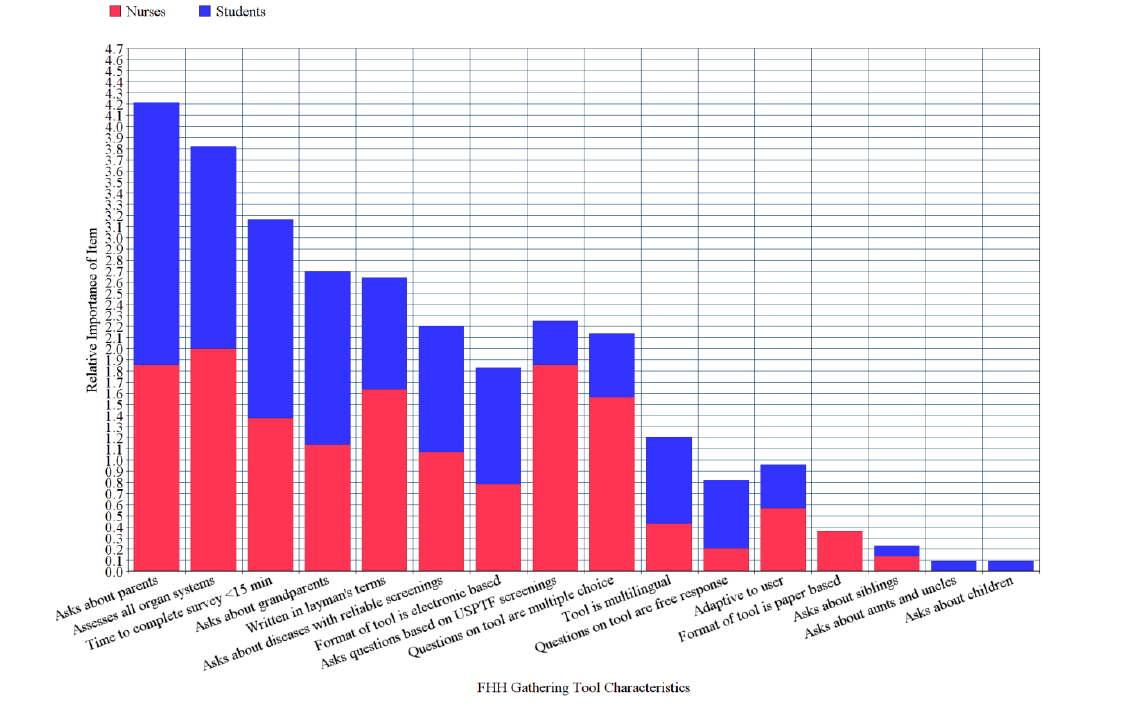Lauren Bretzing and Faculty Mentor: Gaye Ray, Nursing Department
Introduction
Family health history (FHH) is a significant risk factor for many diseases and can help determine which patients need further genetic testing, lifestyle changes, and preventative screenings at earlier ages. Though recognized as an important step in controlling and preventing disease, FHH is often underutilized in health care settings. In a busy clinic setting, many clinicians may only have a couple minutes to discuss FHH with their patient, or may choose to forego it entirely. Apart from being time intensive and inaccurate, the FHH tools available are often seen as too complex. Additionally, a lack of uniformity in the collection, storage, and distribution of FHH further limits the usefulness of this potentially invaluable information. Dozens of questionnaires, surveys, and websites have been created to bridge the gap between the ideal and the practical, but a standard way of collecting FHH has yet to be found. Much of this could be due to the available tools not meeting the needs of primary care practitioners. The purpose of this project was to determine which characteristics are most necessary for a FHH tool for it to be useful in everyday practice.
Methodology
We began this research project by reviewing journal articles concerning 36 FHH tools used around the country for various populations and purposes. From this research, I compiled a list of 16 unique characteristics exhibited in the FHH gathering tools and created an informal survey. Following approval from BYU’s Institutional Review Board (IRB), I disseminated the survey to 14 nurses and 23 nursing students. The nurses worked at Jordan Valley Medical Center and the nursing students were in BYU’s nursing program. The survey instructed that the participant choose their top five most important FHH characteristics (from our list of sixteen) and rank them 1-5, with one being the most important and five being the least important. Once the surveys were collected, each characteristic ranked with a “1” got five points, a “2” got four points, and so on until the last characteristic, ranked “5”, received one point. The points for each characteristic were totaled to determine what the top three characteristics were for both nurses and nursing students. My results were then compared back to our initial literature review of FHH gathering tools to determine if a tool exists that contains the most important characteristics as deemed by nurses and nursing students.
Results
Both nurses and nursing students included “asks about parents” and “assesses all organ systems” in their top three most important characteristics. Additionally, nurses thought that a tool that “asks enough questions to collect information to make recommendations based on the United States Preventive Services Task Force (USPSTF) screening guidelines” was important while students chose “time to complete survey is less than fifteen minutes.” When adjusted for different sample sizes, most characteristics drew an even amount of attention from nurses and nursing students. The biggest exceptions were the importance that nurses placed on USPSTF screenings and multiple-choice rather than free-response questions.
I identified four FHH gathering tools that contained the four overall most important characteristics, as seen in the table below. Of those four tools, two were for use in a clinician’s office and two were for use at home. One tool was a free social media tool designed to share family health history among family members. Each of the four tools assessed for at least 22
conditions the USPSTF has screening guidelines for, and each tool generated some sort of risk algorithm, family tree, or report about other conditions the tool assessed. Three of the four tools optimized the time spent collecting FHH by opening subcategories for positive answers.
Discussion & Conclusion
The goal of my research was to determine what characteristics would make FHH gathering tools more widely used by nurses and nursing students. This research was part of a larger project conducted by Professor Gaye Ray and Dr. Karen Whitt that focuses on family health history collection in both America and Czechia.
In the process of completing this project, the importance of FHH was reiterated to me, and I gained new resolve to always collect this important information. Furthermore, I gained a respect and love of research as I participated in this mentored experience.

